Are you ready to transform your home into a lush oasis? Let’s explore the different types of gardening methods that can help you achieve the garden of your dreams. Gardening offers a variety of methods to choose from, each with its own unique benefits and considerations. From aquaponics to raised gardens, there’s a method for everyone. Understanding the basics of gardening, such as soil quality, sunlight requirements, watering techniques, and garden layout, is crucial for success. Additionally, considering the types of plants and incorporating paths, seating areas, and focal points can enhance the beauty and functionality of the garden.
Key Takeaways
- There are a variety of gardening methods to choose from, including aquaponics, back to Eden gardening, biodynamic gardening, and more.
- Understanding the basics of gardening, such as soil quality and sunlight requirements, is crucial for success.
- Considering the types of plants and incorporating paths, seating areas, and focal points can enhance the beauty and functionality of the garden.
Aquaponics: Combining Plants and Fish for Sustainable Growth
Aquaponics is a fascinating gardening method that harnesses the power of nature to create a sustainable and organic ecosystem in your own backyard. This innovative gardening technique combines the benefits of hydroponics with fish farming. In aquaponics, plants are grown in a liquid medium, which breaks down fish waste and turns it into nitrates, acting as food for the plants. At the same time, fish can be farmed in the same system, providing living fertilizers for the plants.
One of the advantages of aquaponics is that it conserves water. Since the plants grow in water, there’s no need for soil or traditional irrigation. The system recirculates the water, reducing the amount of water needed. Aquaponics is also organic, as it relies on natural fertilizers from the fish, and it can be a sustainable way to grow both plants and fish together. The symbiotic relationship between the fish and the plants promotes healthy and sustainable growth.
While aquaponics can be a bit expensive to set up initially and requires a lot of space, it offers long-term benefits for those who are willing to invest. This innovative method of gardening offers a new way to combine fish farming and plant growing, promoting a sustainable and symbiotic relationship between the two.
Ultimately, aquaponics is just one example of the many innovative gardening techniques available to avid gardeners. From organic gardening methods to traditional gardening techniques, there are countless ways to create a lush and thriving garden right in your own backyard.
Back to Eden Gardening: Nurturing the Soil with Wood Chips
Have you ever heard of Back to Eden gardening? This traditional and sustainable method is gaining popularity among gardeners looking to create healthy soil and long-lasting beauty in their landscapes. Back to Eden gardening involves placing 4-6 inches of wood chips over the soil to protect it and retain moisture. As the wood chips decompose, they add nutrients to the soil, which can create a fertile environment to grow your plants.
Back to Eden gardening is one of the traditional gardening methods that focuses on sustainability. This method is perfect for gardeners who aim to have a natural and chemical-free garden. It works effortlessly to maintain soil quality, keeping it hydrated and at a consistent temperature. Additionally, by keeping the soil covered with a layer of wood chips, it reduces the need for watering and weeding time.
Although Back to Eden gardening can make it challenging to plant seeds and move the wood chips, many gardeners appreciate the benefits of this method. This approach also helps prevent soil erosion and encourages the growth of beneficial microorganisms and earthworms. As a result, the soil remains loose and airy, promoting the health and growth of plants.
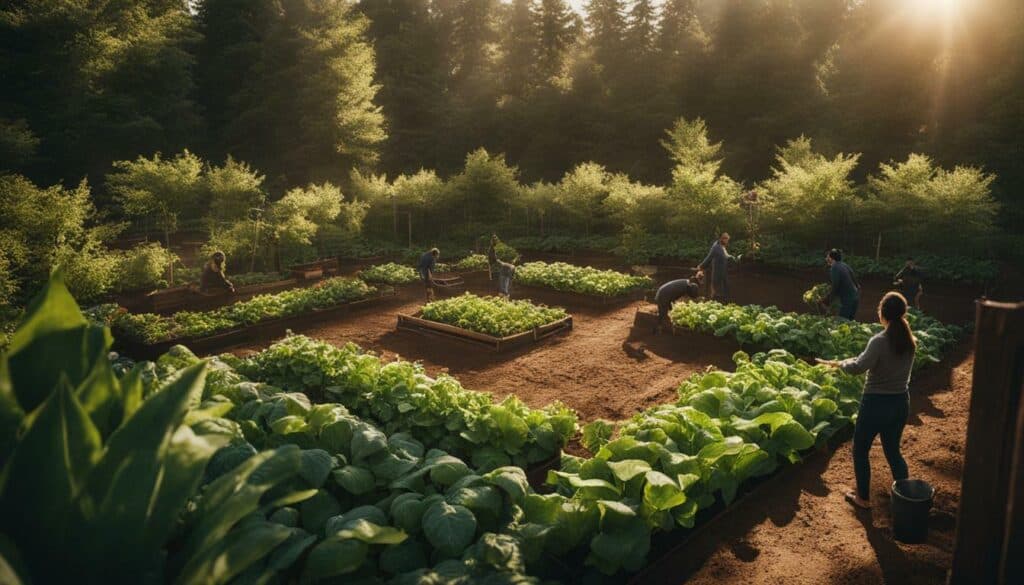
Overall, Back to Eden gardening is a unique and sustainable approach to gardening. If you’re looking for a low-maintenance gardening method that can make your soil healthy and fertile, this method is worth considering. However, if you’re interested in exploring other gardening methods, such as aquaponics, biodynamic gardening, companion planting, container gardening, conventional gardening, core gardening, hugelkultur gardening, hydroponics gardening, in-ground gardening, keyhole gardening, lasagna gardening, mittlieder method, vegetable gardens, flower gardens, herb gardens, and raised gardens, there are plenty of options to choose from.
Biodynamic Gardening: Working in Harmony with Nature’s Rhythms
Biodynamic gardening is a holistic approach that goes beyond traditional gardening methods, emphasizing the interconnections between plants, animals, soil, and the cosmos. This method is similar to organic gardening in terms of avoiding synthetic fertilizers and pesticides, but it places a greater emphasis on the health of the soil. Composting is a critical component of biodynamic gardening, as it is used to create nutrient-rich soil and promote beneficial microorganisms.
Biodynamic gardening is an innovative gardening technique that focuses on building a larger ecosystem and working in harmony with nature’s rhythms. This method emphasizes planting and harvesting according to the phases of the moon and the positions of the stars. Biodynamic gardening also involves creating a diverse range of habitats for insects and wildlife, promoting biodiversity and ecological balance.
Biodynamic gardening differs from other types of gardening methods, including aquaponics, back to Eden gardening, companion planting, container gardening, conventional gardening, core gardening, hugelkultur gardening, hydroponics gardening, in-ground gardening, keyhole gardening, lasagna gardening, Mittlieder method gardening, vegetable gardening, flower gardening, herb gardening, and raised gardening. While all of these methods share a common goal of promoting healthy plant growth, biodynamic gardening takes a more holistic approach, aiming to create a harmonious relationship with nature.
Organic gardening methods are at the core of biodynamic gardening, and the use of synthetic fertilizers and pesticides is strictly avoided. Instead, biodynamic gardening emphasizes creating healthy soil through composting, crop rotation, and cover cropping. By nurturing the soil, biodynamic gardeners believe that they can promote healthy plant growth and improve overall ecosystem health.
If you are interested in innovative gardening techniques and organic gardening methods, biodynamic gardening may be the perfect choice for you. By working in harmony with nature’s rhythms, biodynamic gardeners seek to create thriving gardens that promote biodiversity and ecological balance.
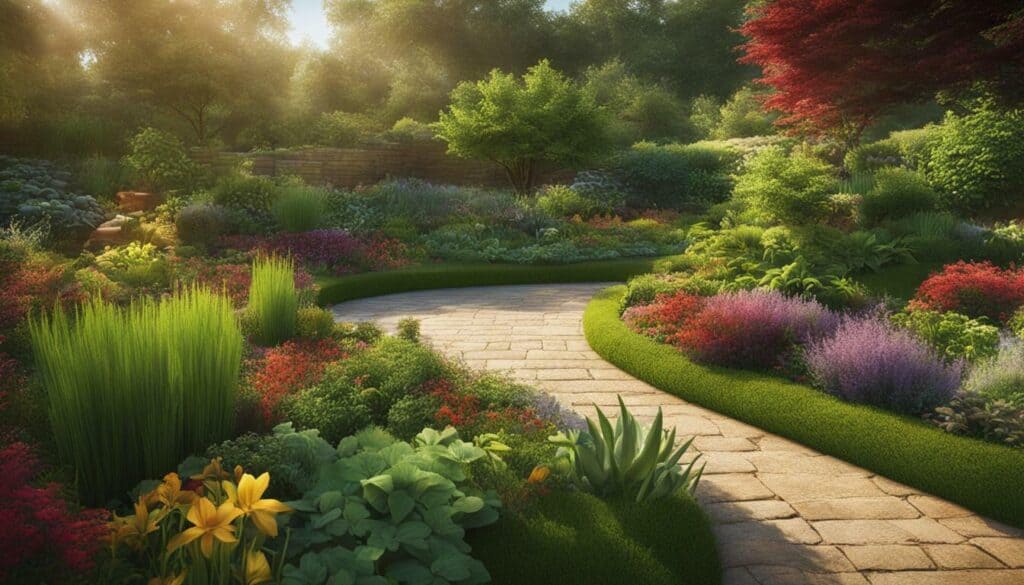
Companion Planting: Growing Crops Together for Mutual Benefits
Discover the secret behind thriving gardens – companion planting, a popular gardening method that harnesses the power of nature’s harmonious relationships. As a gardener, I’m always looking for innovative and sustainable ways to grow my plants. Companion planting is one of my favorite techniques because it allows me to grow different crops together, promoting mutual growth and benefit. This method involves planting crops that repel or attract certain insects to help protect each other from pests and diseases, resulting in healthier and more vigorous growth.
For example, planting basil and borage with tomato plants can result in fewer diseases and pests, while enhancing the flavor of the tomatoes. On the other hand, planting onions and carrots together can help deter carrot fly and onion maggots, respectively.
Companion planting is just one of the many gardening methods available. Aquaponics, back to Eden gardening, biodynamic gardening, container gardening, and more offer a wide range of options for gardeners to choose from. However, it is important to understand the basics of gardening, such as soil quality, sunlight requirements, and watering techniques, in order to create a successful garden. A proper layout and planning of the garden, along with selecting the right plants for the specific climate and soil conditions, can contribute to a beautiful and functional garden space.
If you’re new to gardening, companion planting is a great place to start. It not only benefits your plants but also provides an aesthetically pleasing garden design. By choosing the right plants to grow together, you can create a natural ecosystem that supports the growth of each individual crop. As with any gardening technique, it’s important to do your research and experiment in order to find the best method that works for you and your garden.
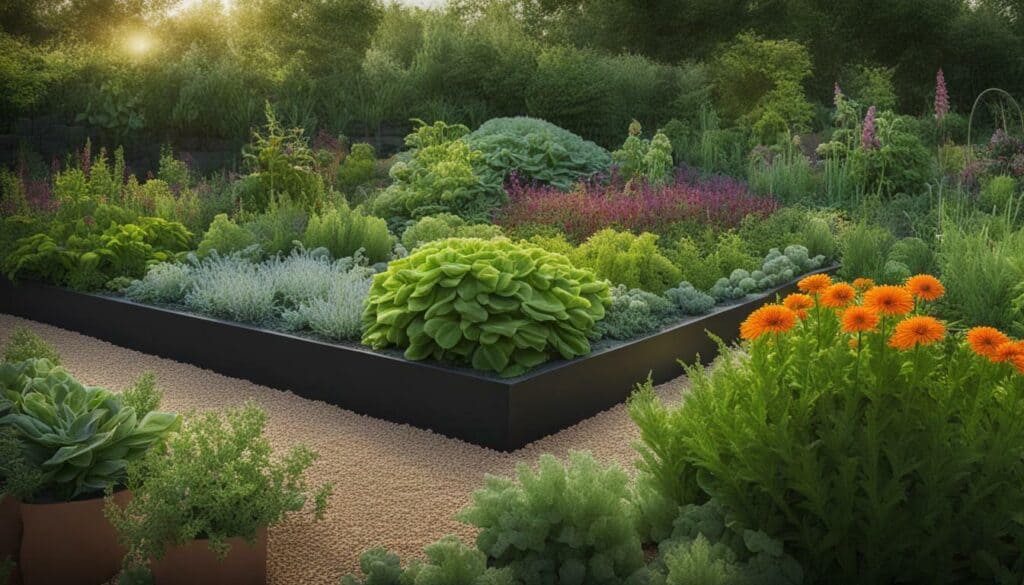
Overall, companion planting is a popular and effective gardening method that utilizes the power of nature’s harmonious relationships. By growing different crops together, you can promote mutual growth and benefit while creating a beautiful and functional garden space. Whether you’re a seasoned gardener or just starting out, companion planting is a technique worth trying out to take your gardening skills to the next level.
Container Gardening: Creating Gardens in Limited Spaces
Don’t let limited space stop you from enjoying the joys of gardening! Container gardening is a versatile and practical method that brings the beauty of plants to any corner of your home. This modern gardening method meets the needs of those who lack access to traditional garden beds, enabling maximal use of space and increased productivity.
Container gardening is ideal for balconies and patios, and can even be done indoors. The cost can be reduced by being creative with containers such as using buckets, old tires, or even dresser drawers. However, it is important to consider soil quality and to enrich it with organic matter for optimal plant growth.
Understanding the sunlight requirements of different plants is crucial, as some need more sun while others prefer shade. Proper watering techniques and frequency are important for plant survival and growth, and water-saving techniques such as mulching can be used.
When planning the garden layout, it is important to choose plants that are adaptable to the specific climate, soil type, and available sunlight. Incorporating focal points, paths, and seating areas can enhance the aesthetic appeal and functionality of the garden.
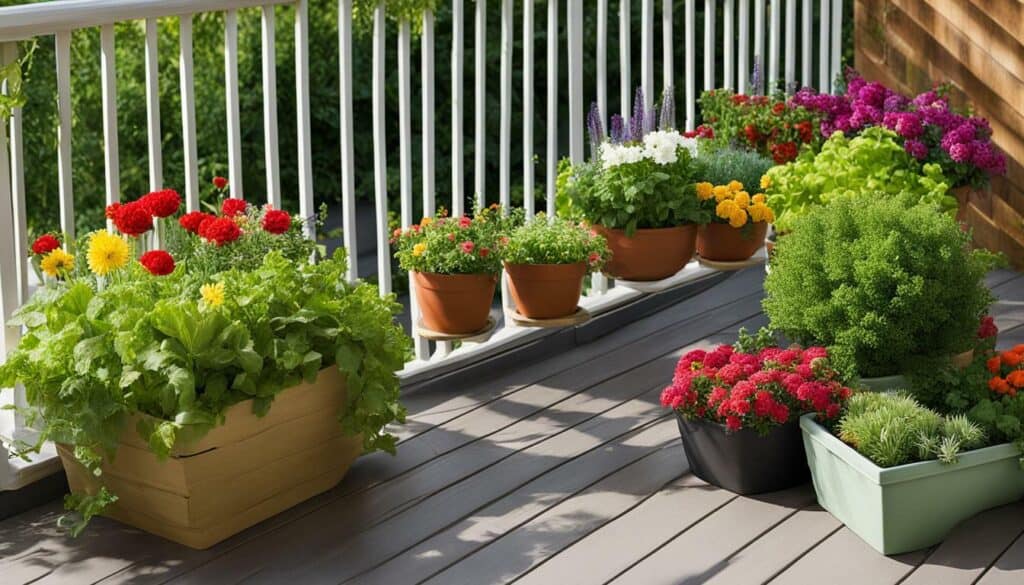
Different types of gardens can be created with container gardening such as vegetable gardens, flower gardens (such as rose, tulip, and orchid gardens), herb gardens (for cooking and medicinal purposes), and raised gardens (for areas with less fertile soil).
Container gardening offers a solution for gardening in limited spaces, allowing individuals to enjoy the beauty and benefits of gardening. So get creative with your containers, choose the right plants, and enjoy the beauty that container gardening can bring to your home.
Conventional Gardening: Traditional Methods with Chemical Support
When it comes to gardening, many people choose the tried-and-true approach of conventional gardening, which relies on chemical fertilizers, pesticides, and herbicides to maintain plant health. This method is the most commonly used and popular gardening method due to its convenience and effectiveness. However, there are other gardening methods available that are more sustainable and organic, such as aquaponics, biodynamic gardening, and hugelkultur gardening.
Despite its popularity, conventional gardening comes with potential trade-offs. The chemicals found in synthetic fertilizers and pesticides can harm beneficial insects and other organisms in the soil, leading to a decrease in soil health and biodiversity over time. Additionally, these chemicals can contaminate groundwater and harm human health if not used properly.
It is important to weigh the advantages and disadvantages of each gardening method and choose the one that best fits your needs and values. Understanding the basics of gardening, such as soil quality, sunlight requirements, watering techniques, and garden layout planning, is crucial for successful gardening using any approach.
Whether you choose to stick with conventional gardening or try out a more sustainable method, such as back to Eden gardening or hydroponics gardening, the most important thing is to enjoy the process and have fun creating your lush garden. Vegetable gardens, flower gardens, herb gardens, and raised gardens are all popular types of gardens that can add beauty and flavor to your landscape.
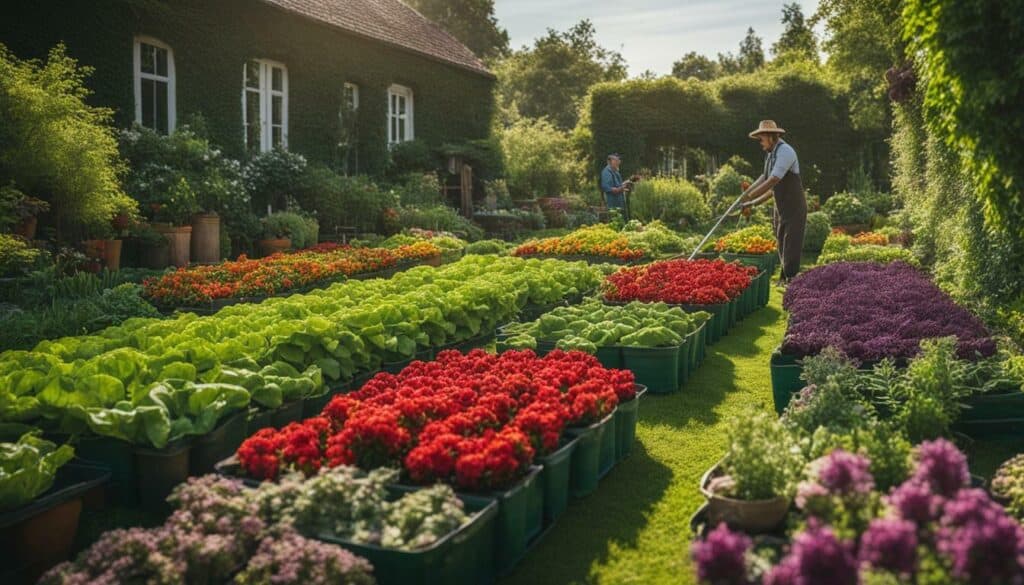
Core Gardening: Maximizing Water Retention with Organic Materials
Let’s dive into the world of core gardening, a sustainable gardening method that focuses on conserving water and improving soil quality through the strategic use of organic materials. This method involves digging a trench in the garden bed and filling it with organic materials and straw to act as a sponge for water. Back to Eden gardening is another technique that can be employed, where wood chips are used to cover the soil, retaining moisture and adding nutrients as they decompose.
Proper watering techniques and frequency are crucial for the success of a garden when using core gardening. Watering the roots of the plants instead of the leaves and watering deeply but infrequently can help promote deeper root growth and conserve water. Additionally, mulching with organic materials can help conserve water and prevent weed growth.
Understanding the sunlight requirements of different plants and planning the garden layout to optimize sunlight exposure is essential for a successful garden. Vegetable gardens, flower gardens, herb gardens, and raised gardens are some of the different types of gardens that can be created using core gardening principles. With core gardening, sustainable and organic gardening is made easy and accessible to anyone with a passion for gardening and a desire to conserve water and improve soil quality.
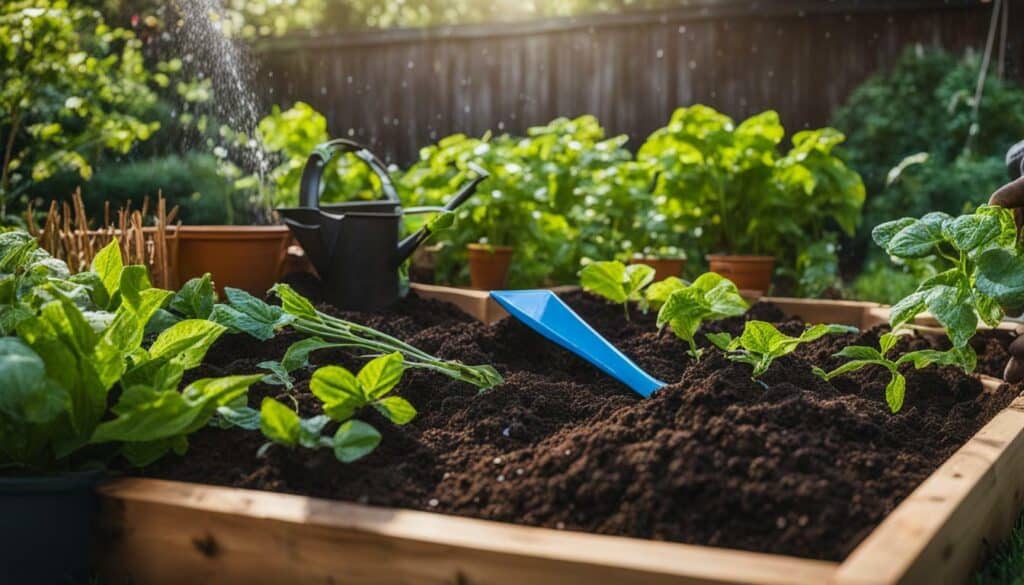
Hugelkultur Gardening: Building Mounds of Natural Fertility
Have you ever considered building garden mounds out of wood and natural materials? Hugelkultur gardening is an innovative and sustainable method that brings fertility and beauty to your garden. This gardening technique involves burying large pieces of wood, branches, leaves, and other organic materials under a layer of soil to create raised garden beds.
The decomposing wood and organic materials release nutrients into the soil, creating a fertile environment for plant growth. The mounds act as sponges, retaining water and minimizing the need for regular watering. This makes hugelkultur gardening an ideal method for those looking to conserve water and create a sustainable garden space.
| Benefits of Hugelkultur Gardening | How to Build a Hugelkultur Garden Bed |
|---|---|
|
|
In addition to its sustainably benefits, hugelkultur gardening is also visually appealing and adds a unique element to your garden space. It is particularly beneficial for those with a surplus of scrap wood and natural materials on their property. By implementing hugelkultur gardening, one can create a sustainable and nutrient-rich garden space that not only promotes plant growth but also contributes to a healthier ecosystem.

Incorporating creative and innovative gardening techniques like hugelkultur gardening can bring a new level of sustainability and beauty to your garden space. By building mounds of natural fertility, you can create a vibrant and thriving garden that brings joy and abundance to your home.
Hydroponics Gardening: Harnessing the Power of Liquid Nutrients
Say goodbye to traditional soil-based gardening and welcome the future with hydroponics gardening – a modern and innovative technique that maximizes plant growth by providing precise nutrients in a controlled environment. Hydroponics gardening is a method that utilizes liquid nutrients to grow plants. It is a soilless garden that uses continuously circulating liquid fertilizer to root the plants. This technique is gaining popularity due to its efficiency and the ability to maximize space.
Hydroponics gardening can be done indoors or outdoors, making it a perfect choice for urban dwellers who don’t have access to a traditional garden space. The technique breaks down fish waste and conserves water by growing plants in a liquid medium, which reduces the need for frequent watering. This method allows for fast growth as the crops have access to all the necessary nutrients, which leads to higher yields and healthier plants.
However, some drawbacks come with the use of hydroponics gardening. Firstly, it can be expensive due to the need for equipment and the installation process. Secondly, it requires the use of synthetic fertilizers, which can be detrimental to the environment. Despite the drawbacks, hydroponics gardening offers a unique and effective way to grow plants, making it a popular option for modern gardeners.
Overall, hydroponics gardening is a great technique to maximize plant growth and create a controlled environment. Its efficient use of space and water, and fast growth rates make it an attractive option for those interested in modern and innovative gardening techniques.
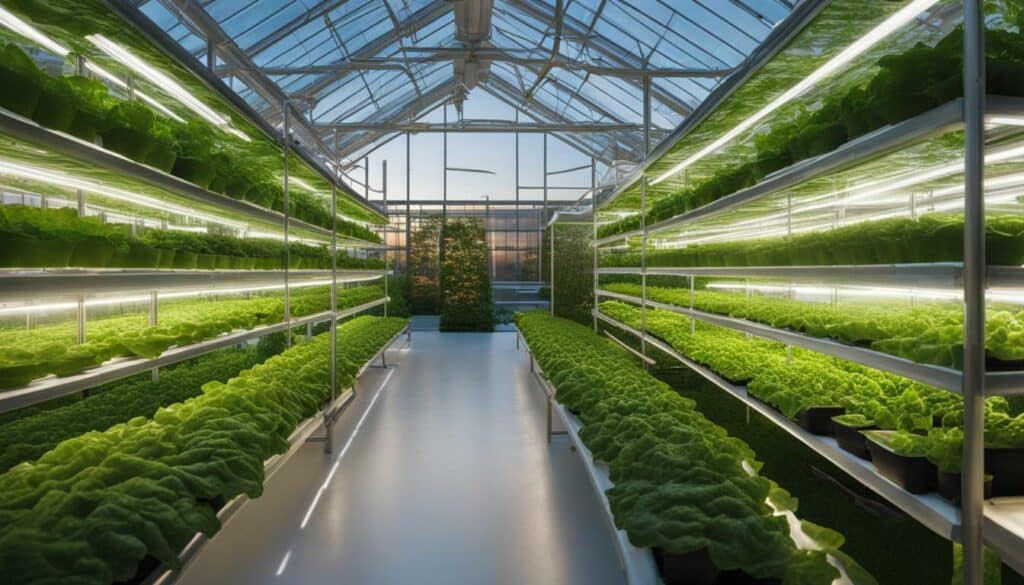
In-Ground Gardening: Simplicity and Natural Growth
In-ground gardening is the tried-and-true method of growing plants directly in the ground, and it remains a popular choice for many gardeners seeking a simple and natural approach. This traditional gardening method requires minimal investment and is a cost-effective way to grow crops and vegetables.
Before starting an in-ground garden, proper soil preparation is necessary to ensure successful growth. Understanding the sunlight requirements of different plants and using proper watering techniques are also essential. In-ground gardening is an excellent choice for beginners, as it is relatively easy to maintain and requires less maintenance than other gardening methods.
Besides vegetable gardens, in-ground gardens can be used for flower gardens, herb gardens, and raised gardens. Flower gardens add aesthetic appeal to yards and come in many different types, such as rose gardens, tulip gardens, and orchid gardens. Herb gardens are often used for cooking and can include popular herbs like basil, rosemary, and mint. Raised gardens are helpful for areas with less fertile soil and can be created using raised garden beds.
While in-ground gardening may not be the most innovative method of gardening, it is undoubtedly one of the most popular and easiest to adopt. By starting an in-ground garden, you can create a relaxing and therapeutic outdoor space while enjoying the satisfaction of producing your food.
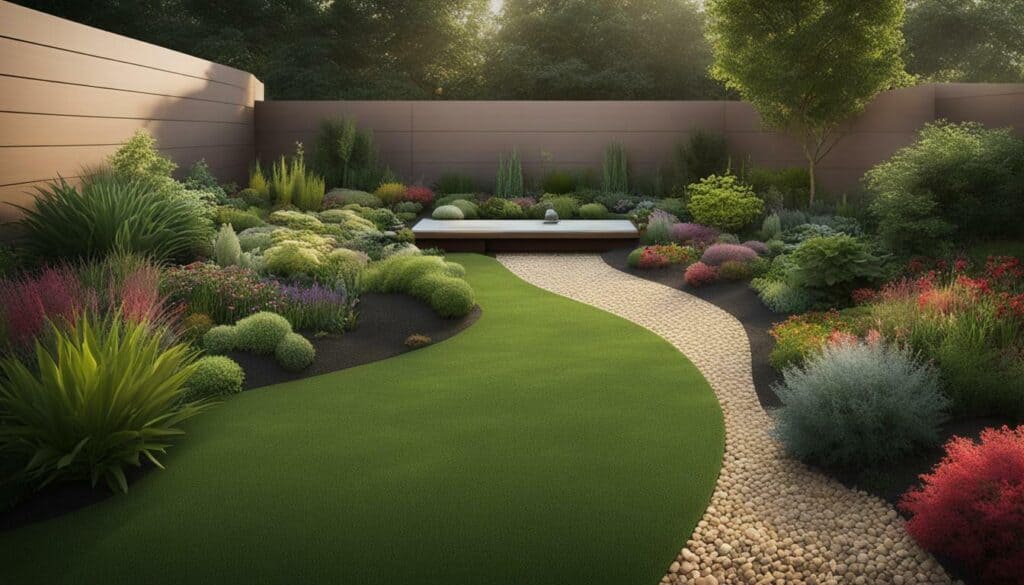
Keyhole Gardening: Circular Raised Beds with a Central Compost Pile
Let’s explore the charming and practical world of keyhole gardening, an innovative gardening technique that combines beauty with functionality to create a bountiful and sustainable garden. Keyhole gardening involves a circular raised bed design with a path in the center, resembling a keyhole. This method allows for efficient water and nutrient distribution, making it an ideal choice for gardeners with limited space or poor soil quality.
The circular shape of the raised bed with a path in the center allows easy access to all areas of the garden. This is especially useful for gardeners with limited mobility as they can reach every plant without straining themselves. The central compost pile serves as a source of organic matter and nutrients, enriching the soil and promoting healthy plant growth. The compost pile is strategically placed in the center of the raised bed, allowing easy access during maintenance.
Keyhole gardening is a sustainable gardening method that utilizes materials that are usually regarded as waste, such as cardboard, paper, and kitchen scraps, to create nutrient-rich soil. By incorporating these materials into the compost pile, individuals can create a circular ecosystem that promotes healthy plant growth, making it a popular choice among organic gardeners.
This innovative gardening technique is an excellent way to create a productive garden in limited space. It is also an excellent option for gardeners who want to reduce their water usage, as the compost pile and the soil’s design retain moisture and reduce evaporation.
If you’re looking for an innovative and sustainable gardening method, keyhole gardening is a technique worth considering. With its circular raised bed design and central compost pile, gardeners can save space, reduce water consumption, and enhance plant growth.
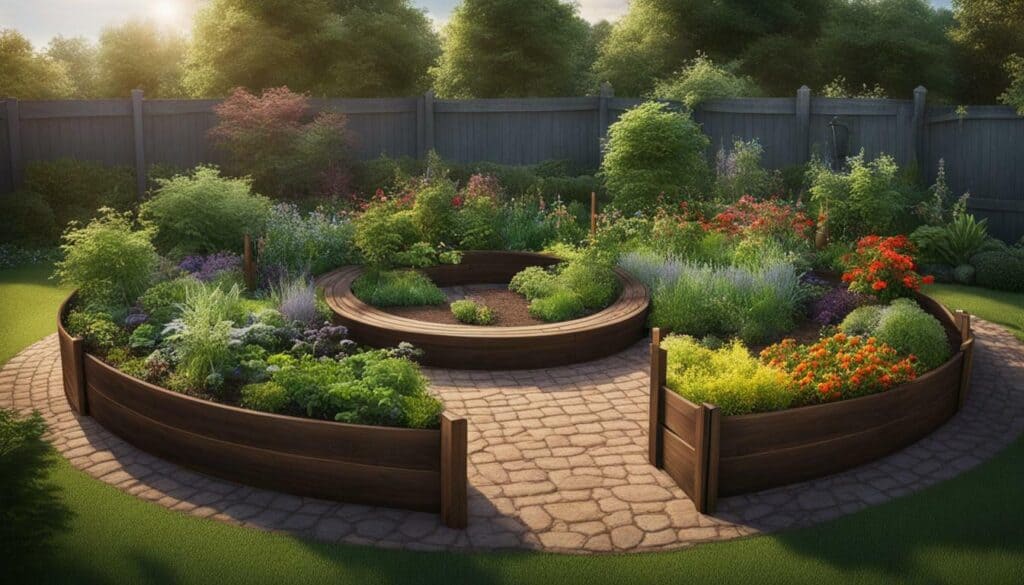
Lasagna Gardening: Layering for Nutrient-Rich Soil
If you’re looking for a no-dig gardening method that produces nutrient-rich soil, then lasagna gardening might be just what you need to create a thriving and organic garden. This popular gardening method involves layering compostable materials in the garden bed instead of digging into the soil.
Lasagna gardening is a form of no-dig gardening and is known for creating nutrient-rich soil. The layers of compostable materials, such as green and brown materials, create a lasagna-like effect that needs to be about 2-feet deep. Over time, the layers decompose and add nutrients to the soil.
One of the benefits of lasagna gardening is that it is a great option for gardens with lots of weeds or for those who don’t want to remove grass from their gardening bed. Additionally, it is an organic gardening method, making it an ideal choice for those seeking a sustainable and eco-friendly gardening option.
So, if you’re looking for a popular and organic gardening method that produces nutrient-rich soil, consider trying lasagna gardening. With a little patience, you can create a thriving and beautiful garden that is free from harmful chemicals and full of healthy and delicious produce.
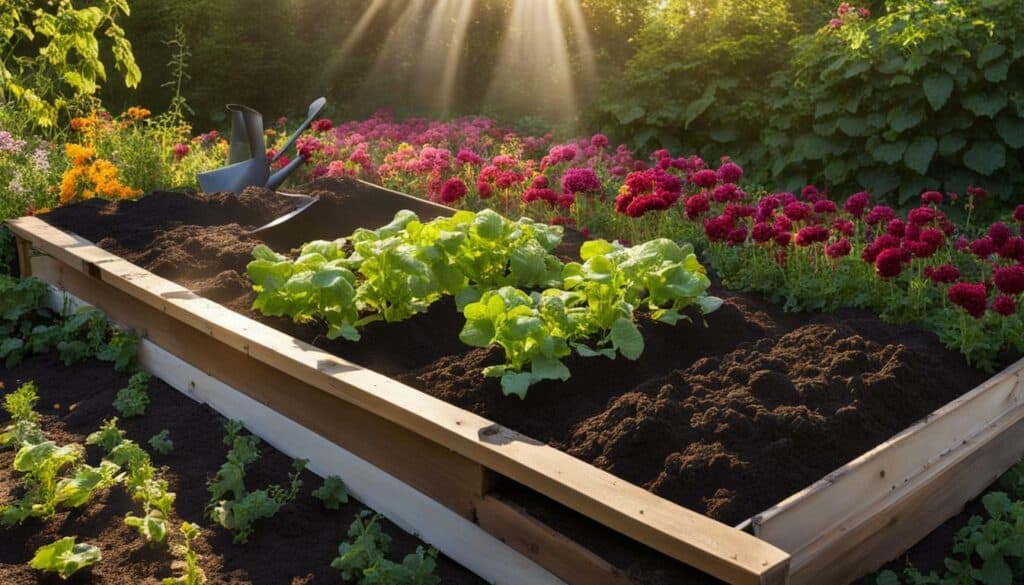
Mittlieder Method: A Blend of Soil-Based and Hydroponic Gardening
Let’s take a closer look at the Mittlieder method, a unique gardening approach that combines traditional soil-based techniques with the efficiency of hydroponic gardening, perfect for maximizing plant growth in small spaces. This innovative gardening technique allows gardeners to grow plants both in soil and in a liquid medium, similar to hydroponics.
The Mittlieder Method is considered an efficient and innovative approach to gardening, as it maximizes space utilization by combining soil-based and hydroponic gardening. This method is suitable for small space gardens and is often combined with vertical gardening to maximize space utilization.
The fish waste in the liquid medium acts as a fertilizer for the plants, while the plants also help filter the water for the fish. This creates a symbiotic relationship between the plants and the fish, resulting in a closed ecosystem that is easy to maintain.
However, it’s important to note that the Mittlieder Method requires careful monitoring and maintenance, as the balance between the liquid medium and soil needs to be carefully managed. Gardeners must also be mindful of the nutrient levels in the liquid medium, as they need to be adjusted regularly to ensure optimal growth.
Overall, the Mittlieder Method is a modern and innovative approach to gardening that allows for maximized plant growth in small spaces. It is perfect for those who want to grow an abundance of plants in a limited area and are willing to put in the extra effort to maintain the balance between the liquid medium and soil.

Understanding the Basics of Gardening: Setting the Foundation for Success
Before diving into the world of gardening methods, it’s crucial to understand the basics that lay the foundation for a thriving garden. The success of any garden depends on factors such as soil quality, sunlight requirements, watering techniques, and garden layout planning.
Testing and amending the soil is one of the most important steps in establishing a successful garden. Knowing the pH level and nutrient content of your soil helps you choose plants that will thrive in that environment.
Understanding sunlight requirements is another critical factor for a successful garden. Pay attention to the amount of sun your garden receives each day and choose plants that are adaptable to your specific conditions.
Proper watering techniques and frequency are also essential for maintaining a healthy garden. Overwatering can lead to root rot and other issues, while underwatering can stunt growth. It’s important to find a balance and water plants only when necessary.
Garden layout planning is also essential to ensure a successful and visually appealing garden. Incorporating paths and seating areas into the design can add a functional and aesthetic aspect to your garden.
When choosing plants, it’s crucial to consider their adaptability to your climate, soil type, and available sunlight, as well as maintenance requirements. Incorporating focal points and groupings can also create visual interest and a sense of harmony in your garden.
Whether you’re planning a vegetable garden, a flower garden, an herb garden, or a raised garden, understanding the basics and implementing proper techniques can help set a solid foundation for success in gardening.
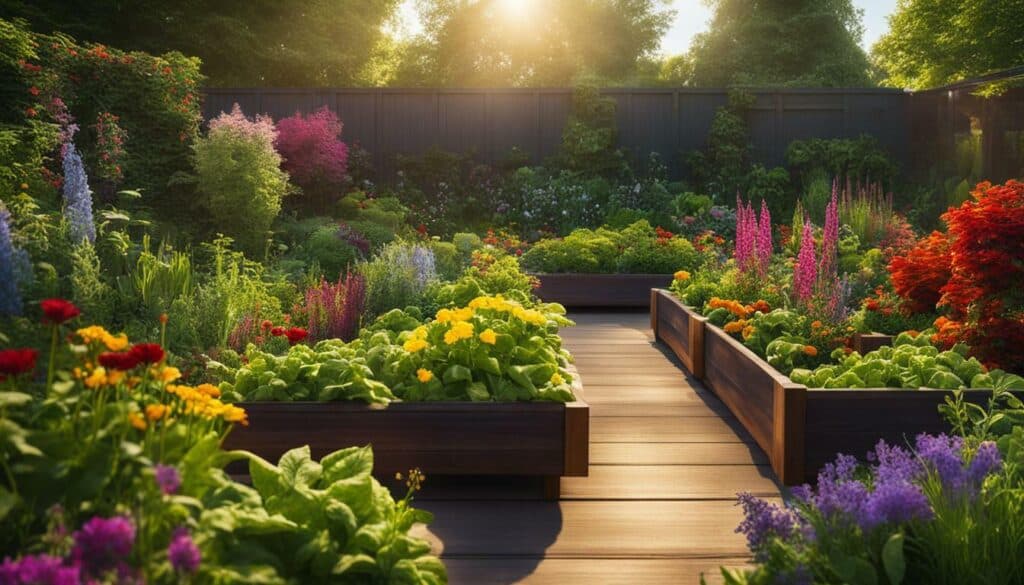
By following these basic gardening principles, you can create a lush and thriving garden that will bring you joy throughout the seasons.
Flower Gardens: Adding Color and Beauty to Your Landscape
Get ready to be mesmerized by the enchanting world of flower gardens, where vibrant colors and intoxicating scents come together to create a stunning landscape that will leave you in awe. There are different types of gardening methods that you can choose from to grow flowers in your garden, each with its own unique benefits and challenges.
One of the important factors to consider when growing flowers is the quality of the soil. Enriching the soil with organic matter, such as compost or well-rotted manure, can greatly improve its texture and drainage, providing your flowers with essential nutrients and support. Additionally, understanding the sunlight requirements of different plants is crucial for successful gardening. Assessing the amount of sunlight your garden receives and designating areas accordingly will help your plants thrive.
Proper watering is essential for plant survival and growth. Monitoring soil moisture levels is important since different plants have different water requirements. Overwatering should be avoided, and techniques such as mulching can help conserve water and prevent weed growth. Planning your garden layout is another important aspect. Consider the size, shape, and functionality of your outdoor space when selecting the right plants.
Flower gardens come in different types and styles, including rose gardens, tulip gardens, and orchid gardens. Incorporating a variety of plants with different colors, textures, and bloom periods will ensure visual interest throughout the year. Herb gardens, which can be used for cooking and spices, and raised gardens, suitable for areas with infertile soil, are also popular choices.
To create a balanced and inviting garden, incorporating focal points, paths, and seating areas can also enhance the overall appeal. Now that you know the fundamental principles of gardening and the different types of flower gardens, you can create a vibrant and thriving garden that will bring beauty and joy to your life.
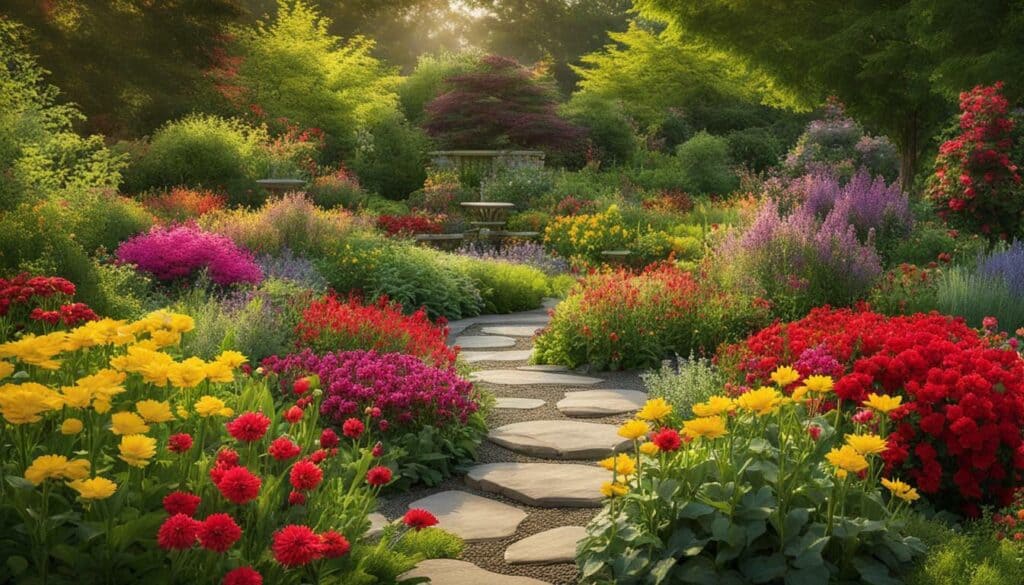
Herb Gardens: Growing Fresh Seasonings at Your Fingertips
Are you a cooking enthusiast seeking to elevate your dishes with fresh and aromatic seasonings? Look no further than herb gardens, where an array of flavorful possibilities awaits. Herb gardens can be grown using various types of gardening techniques such as aquaponics, back to Eden gardening and companion planting.
Container gardening is a popular choice for those with limited space, as it allows you to grow herbs in pots and small containers. Conventional gardening, which involves using chemical fertilizers, is also an option. However, organic gardening methods such as back to Eden and companion planting are more sustainable and healthier for you and the environment.
A successful herb garden requires proper soil quality and sunlight requirements. Understanding different watering techniques and frequency is also crucial for the survival and growth of herbs. Planning the layout of the herb garden is essential, taking into account the size and shape of the space available.
There are various types of herb gardens, including vegetable gardens and flower gardens such as rose, tulip, and orchid gardens. Herb gardens for cooking are practical and offer a fresh supply of seasonings for your culinary creations. Raised gardens are also beneficial for areas with infertile soil.
With proper care and planning, herb gardens can provide fresh herbs for cooking and add beauty to outdoor spaces. So, get planting and enjoy the bountiful flavors and aromas of your very own herb garden!
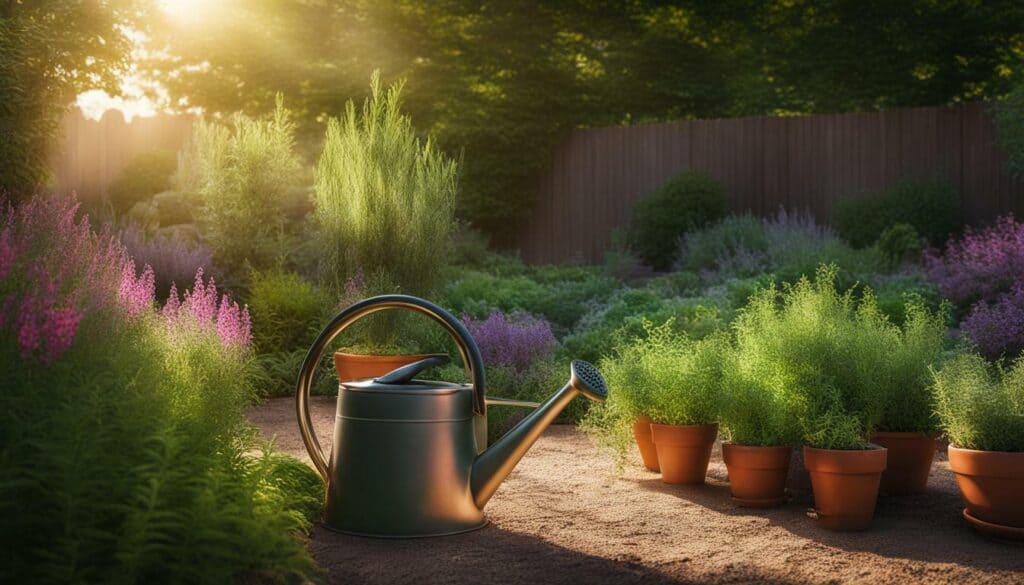
Elevate Your Gardening Experience with Raised Gardens
Raised gardens are a popular method of gardening that allows individuals to take their gardening to new heights. With raised gardens, you can add aesthetic appeal to your landscape, while also providing control over soil quality, drainage, and accessibility. These gardens can be built from various materials, including wood, bricks, or stones, and can be customized to fit any size or shape of the yard.
One of the main benefits of raised gardening is the ability to have complete control over the soil quality. Elevated garden beds provide better drainage, which reduces the risk of root rot and other soil-borne diseases. You can also customize the soil mix to suit the specific needs of your plants. For instance, if you’re growing acid-loving plants such as blueberries, you can add peat moss to make the soil more acidic.
Another key benefit of raised gardening is accessibility. With elevated garden beds, you won’t need to bend down or kneel to tend to your plants, making it a more comfortable and accessible option, especially for older adults or individuals with physical limitations. It also minimizes the risk of pests and weeds making their way into the garden.
Raised gardens are a versatile solution that not only add appeal to your landscape but also provide a great opportunity to cultivate different types of gardens. In addition to vegetable gardens, individuals can explore flower gardens, herb gardens, and even incorporate different types of gardening methods, including aquaponics, back to Eden gardening, biodynamic gardening, companion planting, container gardening, conventional gardening, core gardening, hugelkultur gardening, hydroponics gardening, in-ground gardening, keyhole gardening, lasagna gardening, and the mittlieder method.
Understanding the basics of gardening is vital for creating a thriving raised garden. This includes soil quality, sunlight requirements, watering techniques, and garden layout planning. By applying these basics, individuals can nurture their raised gardens into flourishing green spaces.
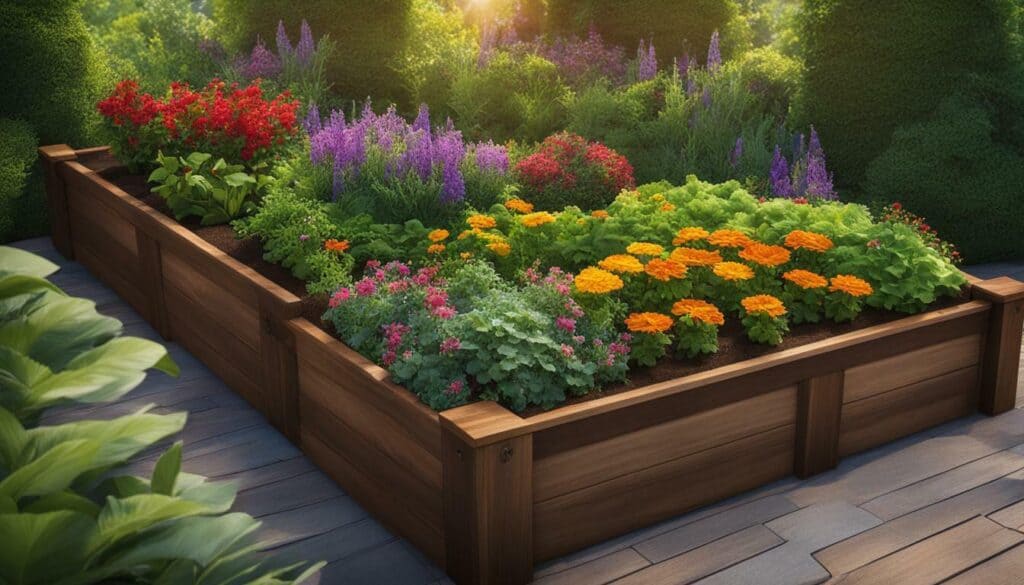
With raised gardens, there is no limit to what you can grow and how you can customize it. So, elevate your gardening experience with a raised garden and explore the different types of gardening methods and gardens available to you, creating a beautiful and thriving outdoor space.
Conclusion
In conclusion, the world of gardening offers a wide range of methods and techniques to suit any gardener’s preference and environment, ensuring a lush and thriving home filled with natural beauty. Choosing the right gardening method is crucial for a successful garden, and options such as aquaponics, back to Eden gardening, and biodynamic gardening promote sustainable and organic growth.
It’s also essential to understand the basics of gardening, including soil quality, sunlight requirements, watering techniques, and garden layout planning. Different types of gardens, such as flower gardens, herb gardens, and raised gardens, each offer unique benefits and aesthetic appeal. By selecting suitable plants for the environment and considering the specific needs of each type of garden, one can create a beautiful and functional outdoor space.
No matter which gardening method or type of garden is chosen, the benefits of cultivating greenery at home are immeasurable. From fresh produce to beautiful blooms, gardening provides a sense of satisfaction and accomplishment while enhancing the overall well-being of both humans and the environment.
FAQ
Q: What is aquaponics?
A: Aquaponics is a method of gardening that combines growing plants in a liquid medium with fish farming. The plants grow in water, and the fish waste acts as a natural fertilizer.
Q: What is back to Eden gardening?
A: Back to Eden gardening involves covering the soil with wood chips to retain moisture and add nutrients over time. This method promotes sustainable and natural growth.
Q: What is biodynamic gardening?
A: Biodynamic gardening focuses on building a larger ecosystem and working with the natural rhythm of nature. It takes into account lunar cycles and the overall balance of the garden.
Q: What is companion planting?
A: Companion planting is the practice of planting different crops together to encourage growth and deter pests and diseases. Certain plants have natural properties that benefit others when grown nearby.
Q: What is container gardening?
A: Container gardening is a space-saving method where plants are grown in containers instead of directly in the ground. It requires more frequent watering but allows for flexibility in small spaces.
Q: What is conventional gardening?
A: Conventional gardening refers to the use of chemical fertilizers, pesticides, and herbicides for plant growth and pest control. It is a popular method but may have potential trade-offs.
Q: What is core gardening?
A: Core gardening involves creating trenches in the garden bed filled with organic materials and water. This improves water retention in the soil and promotes better plant growth.
Q: What is hugelkultur gardening?
A: Hugelkultur gardening utilizes scrap wood and organic materials to create mounds that hold water and break down over time, providing nutrients to the plants. It is a sustainable gardening method.
Q: What is hydroponics gardening?
A: Hydroponics gardening is a soil-less method where plants are grown using liquid fertilizers and water-soluble nutrients. This allows for faster plant growth and efficient nutrient absorption.
Q: What is in-ground gardening?
A: In-ground gardening refers to growing plants directly in the ground. It is a cost-effective method but requires regular maintenance, such as weeding and soil preparation.
Q: What is keyhole gardening?
A: Keyhole gardening is a circular raised bed design with a central compost pile. The compost provides moisture and nutrients to the surrounding plants, creating a self-sustaining garden.
Q: What is lasagna gardening?
A: Lasagna gardening involves layering compostable materials in the garden bed without digging. Over time, these layers break down and create nutrient-rich soil for healthy plant growth.
Q: What is the Mittlieder method?
A: The Mittlieder method combines soil-based and hydroponic gardening techniques to maximize plant growth. It is especially useful for small spaces where soil quality may be a challenge.
Q: What are the basics of gardening?
A: The basics of gardening include understanding soil quality, sunlight requirements, watering techniques, and proper garden layout planning. These factors are essential for a successful garden.
Q: What are flower gardens?
A: Flower gardens are areas specifically designed for growing various types of flowers, including roses, tulips, and orchids. They add color and beauty to the landscape.
Q: What are herb gardens?
A: Herb gardens are gardens where herbs used for cooking ingredients and spices are grown. They provide fresh seasonings and can be conveniently accessed for culinary purposes.
Q: What are raised gardens?
A: Raised gardens are gardens created above ground level, usually in raised beds. They allow for better control over soil quality, drainage, and can be used in areas with infertile soil.
How Can Garden Basins Help in Creating a Lush Backyard Oasis?
Garden basins play a crucial role in cultivating a lush backyard oasis. These water features provide a constant supply of essential moisture for plants and create a serene ambiance. By incorporating garden basins strategically, you can enhance the overall aesthetics and promote the growth of a thriving and vibrant garden within your own backyard oasis.
Source Links
- https://www.gardeningchannel.com/top-gardening-methods-explained/
- https://www.unsustainablemagazine.com/creating-a-beautiful-garden/
- https://www.homestratosphere.com/types-of-gardens/
- https://morningchores.com/gardening-methods/
- https://migardener.com/blogs/blog/different-gardening-methods-and-the-pros-and-cons-of-each
- https://www.theaquaponicsource.com/what-is-aquaponics/
- https://gogreenaquaponics.com/blogs/news/what-is-aquaponics-blog
- https://gogreenaquaponics.com/blogs/news/what-is-aquaponics-and-how-does-it-work
- https://www.epicgardening.com/back-to-eden-gardening/
- https://homesteadingfamily.com/back-to-eden-gardening-with-paul-gautschi/
- https://thepeasantsdaughter.net/back-to-eden-gardening/
- https://www.growingagreenerworld.com/biodynamic-gardening-an-overview/
- https://www.biodynamic.org.uk/garden/biodynamic-gardening/
- https://www.heartandsoilmagazine.com/planting-calendar
- https://www.almanac.com/companion-planting-guide-vegetables
- https://runamukacres.com/companion-planting-made-easy/
- https://www.epicgardening.com/companion-planting-fad-or-science/
- https://www.almanac.com/content/container-gardening-vegetables
- https://extension.umn.edu/yard-and-garden-news/gardening-small-spaces
- https://swanhose.com/blogs/general-gardening/container-gardening-made-easy-a-beginner-s-guide-to-growing-plants-in-small-spaces
- https://www.catesgarden.com/blogs/garden/conventional-gardening-organic-gardening-the-differences
- https://diynatural.com/gardening-techniques/
- https://www.gardeningchannel.com/core-gardening-method-instructions/
- https://morningchores.com/core-gardening/
- https://www.highmowingseeds.com/blog/5-water-retention-methods/
- https://www.almanac.com/what-hugelkultur-ultimate-raised-bed
- https://abundantpermaculture.com/hugelkultur-garden-beds/
- https://www.bhg.com/what-is-hugelkultur-gardening-7487034
- https://sitn.hms.harvard.edu/flash/2019/hydroponics-the-power-of-water-to-grow-food/
- https://gardenboss.org/hydroponic-growing-systems/
- https://www.advancednutrients.com/articles/know-about-hydroponics-gardening/
- https://foodprint.org/blog/gardening-method/
- https://www.almanac.com/gardening-methods-overview
- https://bonnieplants.com/blogs/garden-fundamentals/how-to-plant-an-in-ground-garden-its-easy
- https://www.bobvila.com/articles/keyhole-gardening/
- https://www.gardengatemagazine.com/articles/projects/all/how-to-build-a-keyhole-garden-bed/
- https://food52.com/blog/26102-how-to-build-a-keyhole-garden-bed
- https://homesteadingfamily.com/how-to-use-the-lasagna-gardening-method-or-layering-method/
- https://www.thespruce.com/how-to-make-a-lasagna-garden-2539877
- https://getbusygardening.com/lasagna-gardening/
- https://farmfromhome.com/mittleidermethodreview/
- https://backyardville.com/mittleider-gardening-method/
- https://growfood.com/
- https://www.gardendesign.com/how-to/
- https://www.thespruce.com/how-to-start-a-garden-from-scratch-2132778
- https://extension.psu.edu/trees-lawns-and-landscaping/home-gardening
- https://www.bhg.com/gardening/design/styles/successful-flower-garden-design/
- https://www.gardeners.com/how-to/garden-design-color-schemes/9366.html
- https://www.thespruce.com/flower-garden-ideas-4174111
- https://www.gardenary.com/blog/the-ultimate-guide-to-growing-herbs
- https://www.gardeners.com/how-to/herb-garden/5068.html
- https://gardenerspath.com/plants/herbs/grow-herbs/
- https://minnetonkaorchards.com/raised-bed-gardening/
- https://joegardener.com/podcast/raised-bed-gardening-pt-1/
- https://www.indiatimes.com/lifestyle/gardening/different-types-of-gardening-methods-596426.html

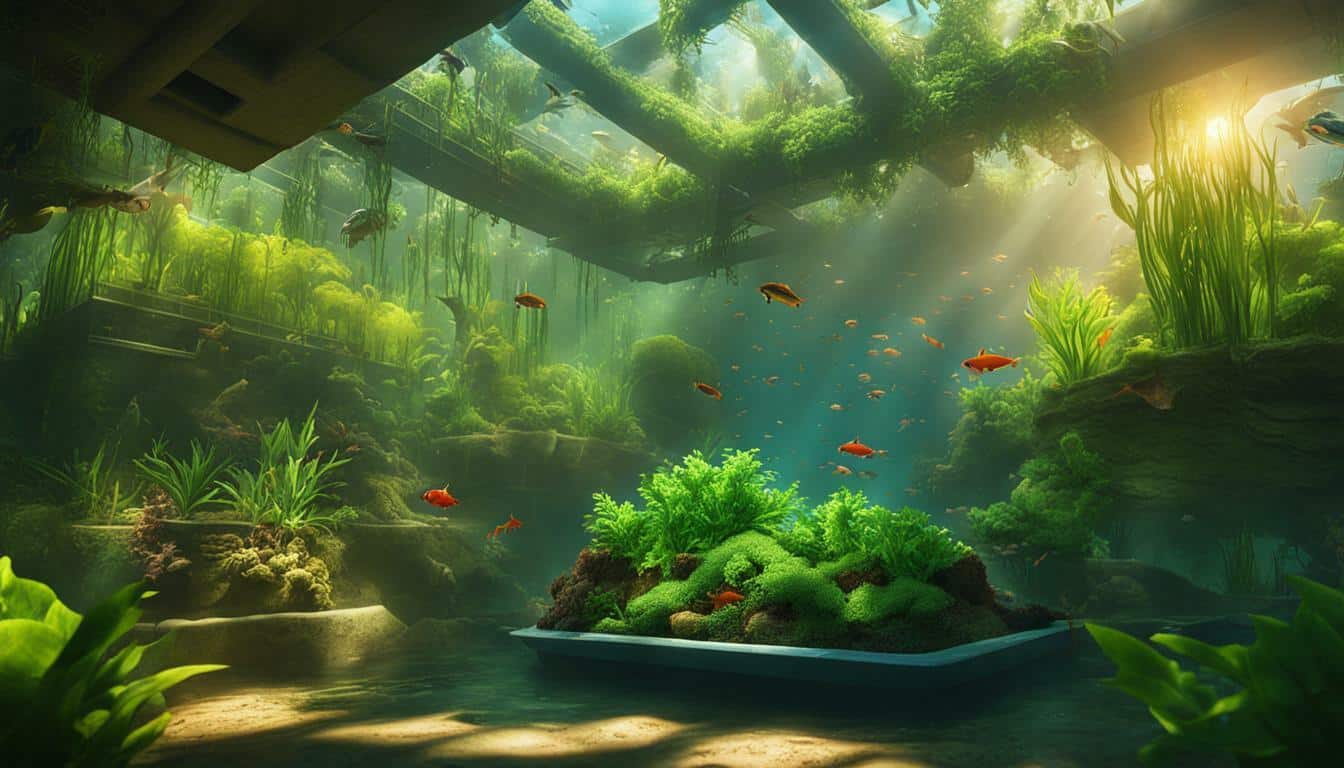



Leave a Reply